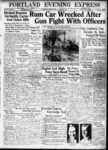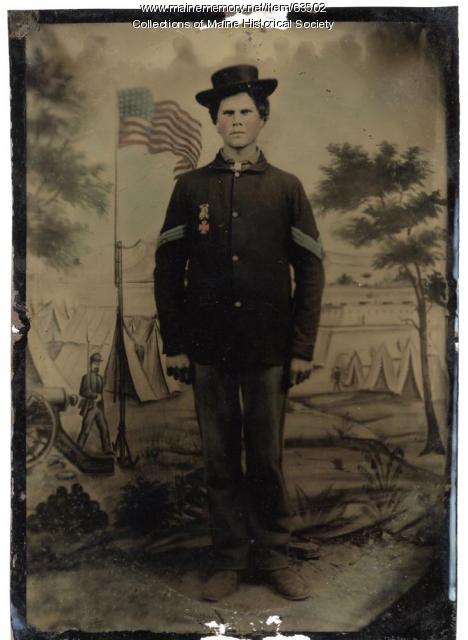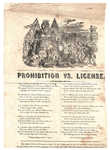Keywords: Foundings
- Historical Items (1124)
- Tax Records (1)
- Architecture & Landscape (28)
- Online Exhibits (158)
- Site Pages (423)
- My Maine Stories (79)
- Lesson Plans (5)
Online Exhibits
Your results include these online exhibits. You also can view all of the site's exhibits, view a timeline of selected events in Maine History, and learn how to create your own exhibit. See featured exhibits or create your own exhibit
Exhibit
In Maine, like many other states, a newly formed Ku Klux Klan organization began recruiting members in the years just before the United States entered World War I. A message of patriotism and cautions about immigrants and non-Protestants drew many thousands of members into the secret organization in the early 1920s. By the end of the decade, the group was largely gone from Maine.
Exhibit
Anshe Sfard, Portland's Early Chassidic Congregation
Chassidic Jews who came to Portland from Eastern Europe formed a congregation in the late 19th century and, in 1917, built a synagogue -- Anshe Sfard -- on Cumberland Avenue in Portland. By the early 1960s, the congregation was largely gone. The building was demolished in 1983.
Exhibit
Rum, Riot, and Reform - Bootleggers vs. Police
"The majority no doubt, obeyed the laws, but many found ingenious ways to drink, hide, transport, and sell spirits."
Exhibit
Rum, Riot, and Reform - Quenching the Thirst
"Bunker found Bangor "the one place east of Boston where you can enter a gilded saloon and get an honest drink of pure liquor." Meanwhile, Portland…"
Exhibit
Music in Maine - Country Music
"… who played piano and taught some music in school, found out that I could sing and encouraged me. The instrument that I was most drawn to was guitar."
Exhibit
Home: The Longfellow House & the Emergence of Portland
The Wadsworth-Longfellow house is the oldest building on the Portland peninsula, the first historic site in Maine, a National Historic Landmark, home to three generations of Wadsworth and Longfellow family members -- including the boyhood home of the poet Henry Wadsworth Longfellow. The history of the house and its inhabitants provide a unique view of the growth and changes of Portland -- as well as of the immediate surroundings of the home.
Exhibit
Eternal Images: Photographing Childhood
From the earliest days of photography doting parents from across Maine sought to capture images of their young children. The studio photographs often reflect the families' images of themselves and their status or desired status.
Exhibit
Hermann Kotzschmar: Portland's Musical Genius
During the second half of the 19th century, "Hermann Kotzschmar" was a familiar household name in Portland. He spent 59 years in his adopted city as a teacher, choral conductor, concert artist, and church organist.
Exhibit
From French Canadians to Franco-Americans
French Canadians who emigrated to the Lewiston-Auburn area faced discrimination as children and adults -- such as living in "Little Canada" tenements and being ridiculed for speaking French -- but also adapted to their new lives and sustained many cultural traditions.
Exhibit
Wired! How Electricity Came to Maine
As early as 1633, entrepreneurs along the Piscataqua River in southern Maine utilized the force of the river to power a sawmill, recognizing the potential of the area's natural power sources, but it was not until the 1890s that technology made widespread electricity a reality -- and even then, consumers had to be urged to use it.
Exhibit
This Rebellion: Maine and the Civil War
For Mainers like many other people in both the North and the South, the Civil War, which lasted from 1861-1865, had a profound effect on their lives. Letters, artifacts, relics, and other items saved by participants at home and on the battlefield help illuminate the nature of the Civil War experience for Mainers.
Exhibit
Civil War Soldiers Impact Pittsfield
Although not everyone in town supported the war effort, more than 200 Pittsfield men served in Civil War regiments. Several reminders of their service remain in the town.
Exhibit
Northern Threads: Silhouettes in Sequence, ca. 1780-1889
A themed exhibit vignette within "Northern Threads Part I," featuring a timeline of silhouettes from about 1775 through 1889.
Exhibit
Chansonetta Stanley Emmons: Staging the Past
Chansonetta Stanley Emmons (1858-1937) of Kingfield, Maine, experimented with the burgeoning artform of photography. Starting in 1897, Emmons documented the lives of people, many in rural and agricultural regions in Maine and around the world. Often described as recalling a bygone era, this exhibition features glass plate negatives and painted lantern slides from the collections of the Stanley Museum in Kingfield on deposit at Maine Historical Society, that present a time of rapid change, from 1897 to 1926.
Exhibit
Hiking, Art and Science: Portland's White Mountain Club
In 1873, a group of men, mostly from Portland, formed the second known hiking club in the U.S., the White Mountain Club of Portland, to carry out their scientific interests, their love of hiking and camaraderie, and their artistic interests in painting and drawing the features of several of the White Mountains.
Exhibit
The War was not going well for the Union and in the summer of 1862, when President Lincoln called for an additional 300,000 troops, it was not a surprise to see so many men enlist in an attempt to bring proper leadership into the Army.
Exhibit
Most societies have had rituals or times set aside to honor ancestors, those who have died and have paved the way for the living. Memorial Day, the last Monday in May, is the day Americans have set aside for such remembrances.
Exhibit
Maine has some 17 million acres of forest land. But even on a smaller, more local scale, trees have been an important part of the landscape. In many communities, tree-lined commercial and residential streets are a dominant feature of photographs of the communities.
Exhibit
Liberty Threatened: Maine in 1775
At Lexington and Concord, on April 19, 1775, British troops attempted to destroy munitions stored by American colonists. The battles were the opening salvos of the American Revolution. Shortly, the conflict would erupt in Maine.
Exhibit
Throughout the history of the state, residents have protested, on paper or in the streets, to increase rights for various groups, to effect social change, to prevent social change, or to let their feelings be known about important issues.
Exhibit
When America entered the Great War in 1917, the government sent out pleas for help from American women, many of whom responded at the battle front and on the home front.
Exhibit
Success at riding a bike mirrored success in life. Bicycling could bring families together. Bicycling was good for one's health. Bicycling was fun. Bicycles could go fast. Such were some of the arguments made to induce many thousands of people around Maine and the nation to take up the new pastime at the end of the nineteenth century.
Exhibit
Father John Bapst: Catholicism's Defender and Promoter
Father John Bapst, a Jesuit, knew little of America or Maine when he arrived in Old Town in 1853 from Switzerland. He built churches and defended Roman Catholics against Know-Nothing activists, who tarred and feathered the priest in Ellsworth in 1854.
Exhibit
Rum, Riot, and Reform - A Call to Temperance
"… one "shee-rumseller" is listed, but women soon found the trade lucrative. Kitty Kentuck (ca. 1810-1866), was the street name for Portland's most…"
























